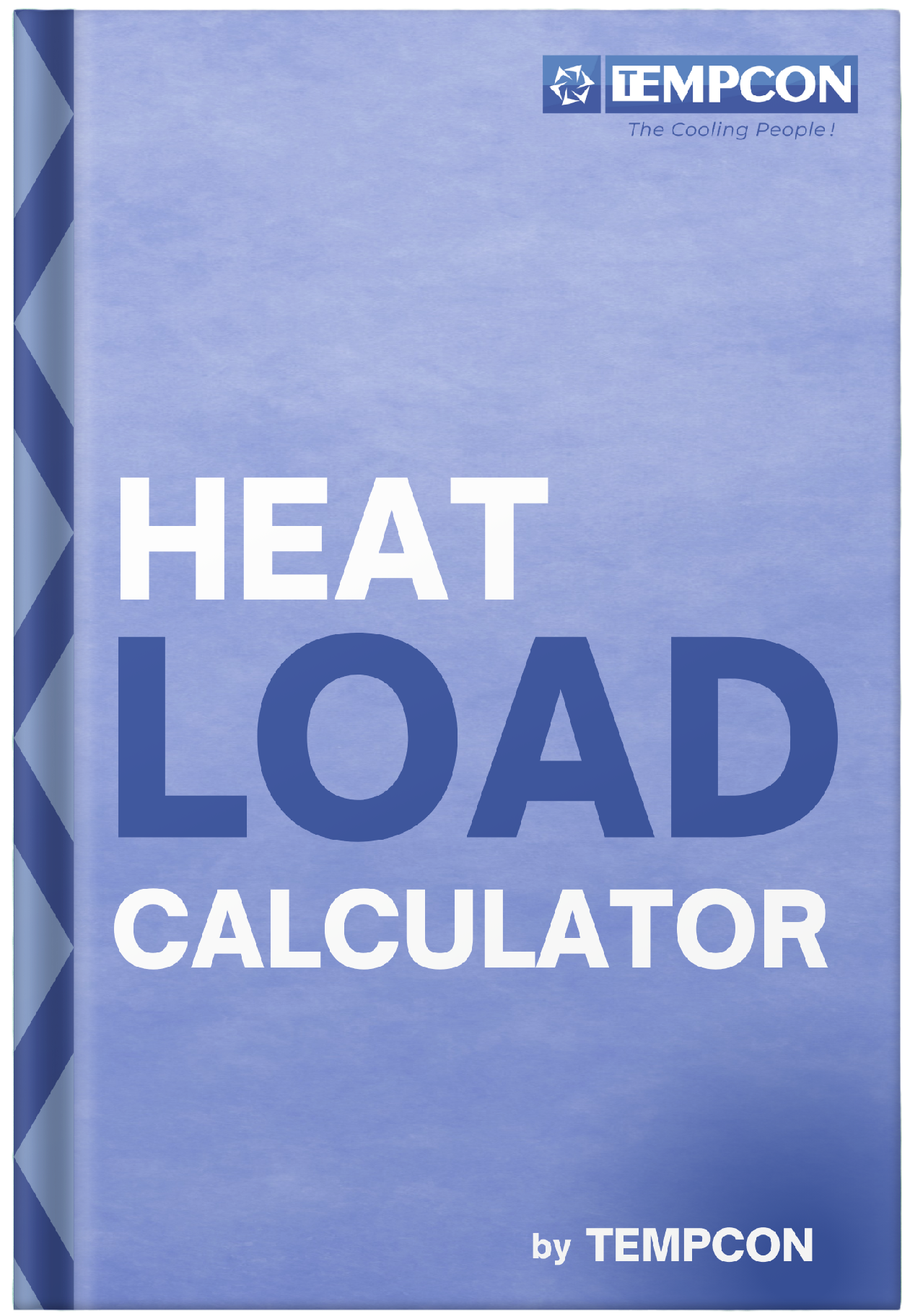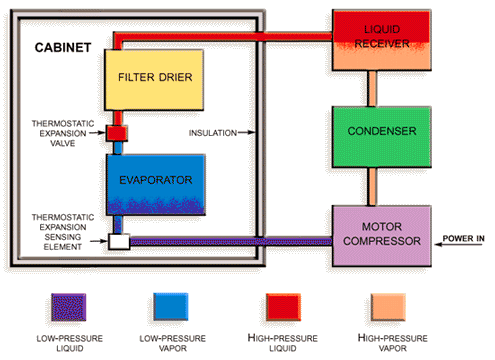 Free Heat Load Calculator
Free Heat Load Calculator
 Free Heat Load Calculator
Free Heat Load Calculator
 Free Heat Load Calculator
Free Heat Load Calculator
An industrial chiller is a cooling system that works like a fridge but for industrial purposes. It takes heat from water and moves it somewhere else, usually into the air or another body of water. It’s made up of a few parts:
To use it, you fill the tank with water or a special mix, connect it to whatever needs cooling, and power it up. The controller helps set the right temperature, flow, and pressure. It’s flexible and comes in different sizes for various jobs, like grain chilling, concrete batching, injection moulding, food processing, and more.
|
Water |
Air |
| 1. Adequate water supply available from tower or well source | 1. Adequate water supply not available from tower or well sources. |
| 2. Water supply is of good quality. | 2. Water supply is not of good quality. |
| 3. Heat recovery is not practical or unimportant. | 3. Heat recovery is practical and important. |
| 4. Plant ambient temperatures consistently exceed 95º F. | 4. Plant ambient temperatures will not consistently exceed 95º F. |
| 5. Ambient air is polluted with large dust and dirt particles. | 5. Ambient air is not polluted with large dust and dirt particles. |
Investing in a chiller offers numerous benefits for various industries:
Equipment Protection: A chiller safeguards expensive processing equipment, ensuring its longevity and reliability, which outweighs its cost.
Increased Production: Maintaining consistent cooling temperatures enhances production speed and accuracy, reducing part rejections and boosting hourly output.
Precise Temperature Control: Industrial chillers ensure stable temperatures, which is crucial for flawless industrial processes, scientific experiments, and medical applications, preventing defects and equipment damage.
Improved Efficiency: By preventing overheating, chillers keep machinery operating optimally, reducing breakdowns, lowering energy consumption, and cutting maintenance costs.
Enhanced Product Quality: Proper temperatures maintained by chillers are vital in preserving product quality in various industries, reducing waste, improving customer satisfaction, and bolstering brand reputation.
Industrial chillers aren’t one-size-fits-all. Consider your temperature needs, the type of chiller, required refrigerant, safety aspects, and your budget. Each chiller is designed for specific temperatures and fluid flow rates. Also, factor in the type of fluid being cooled—different chillers are needed for distilled water versus tap water due to their corrosive effects on certain materials. For more information, refer to our industrial solutions buying guide.
Industrial process chillers find various applications in different industries:
The refrigeration process in industrial chillers involves four main components: compressor, condenser, metering device, and evaporator. Here’s how it works:
The cycle begins as the compressor pumps the refrigerant gas to the condenser, where heat is removed, causing it to condense into a liquid. The metering device then lowers the pressure of the liquid refrigerant, making it easier to evaporate. When it disappears in the evaporator, it absorbs heat from the surroundings, which cools the targeted area. The refrigerant is then directed back to the compressor, and the process repeats continuously. This cycle effectively removes heat from one place and relocates it to another, achieving refrigeration.
In essence, refrigeration involves manipulating the state of a refrigerant to absorb and release heat, allowing for controlled cooling in industrial settings.

Chiller
Chiller– How to Choose
What is the Application?
Knowledge of the application may allow you to skip several steps
What is the Temperature Range?
< 30°C? Think refrigeration >30°C? Think Heating only
What Temperature Stability is Required?
±0.01°C? Think circulator ±0.5°C? Think chiller
Closed Loop or Open Bath Application?
If closed loop, think anything but immersion circulator
How Much Cooling Power is Required?
Modest (100 – 700 watts) Strong (750 & up) Think circulator Think chiller
What are the Pumping Requirements:
| Chillers |
| Magnetic Drive Centrifugal – fixed flow/ fixed pressure |
| Positive Displacement – fixed flow/adjustable pressure |
| Turbine – adjustable flow or pressure |
Other Requirements?
Remote probe
RS232 port
Expanded programming capabilities
Special fluids – watch compatibility and safety
Overall
Select chillers to provide best cooling power / heat removal
Chillers have many applications. For industrial use:
For laboratory use:
Choosing the right size recirculating chiller adds to the economies of its use. The optimum size needed is based on the amount of heat your application is generating, plus additional power to maintain temperature under varying loads.
Normally the manufacturer of the equipment you are cooling will supply heat removal information, which will include BTU/hr or watts to be removed along with flow rate and desired and inlet and outlet temperatures for the equipment.
If information isn’t available, here’s how to calculate the heat load of your system:
BTU/hr = (T1-T2) x gpm x 60 min/hr x 8.33 lb/gal x Cp
T1 = temperature of coolant leaving the equipment, deg F
T2 = temperature of coolant entering the equipment, deg F
gpm = gallons per minute of coolant flowing through the equipment
Cp = specific heat of coolant; Water = 1.0
Measure temperature with the same thermometer if possible of with two thermometers of known accuracy. Measure gpm using a flowmeter of by collecting the coolant in a known volume for a given period of time.
Additional Considerations:
Conversions:
Watts = BTU/hr / 3.413
Tons = (BTU’s / hr) / 12,000
To determine the cooling required for your plastic processing, use this formula: [(Pounds per hour being processed) / Material Factor] * 3519 = Watts of cooling required.
For example, if you’re injection moulding Nylon at a rate of 220 lb/hr and Nylon’s material factor is 40:
(220/40) * 3519 = 19355 Watts
For conversions:
Refer to the cooling capacity chart for models like DCA750 or DCW750 from DuraChill based on your calculated cooling needs.
Here are material factors for different processes:
INJECTION MOLDING
30 lbs/hour HDPE
35 lbs/hour LDPE
35 lbs/hour Acrylic
35 lbs/hour Polyproplene
40 lbs/hour Nylon
40 lbs/hour Delrin
40 lbs/hour Urethane
45 lbs/hour PET
50 lbs/hour Polystyrene
50 lbs/hour ABS
50 lbs/hour Polycarbonate
50 lbs/hour Acetal
70 lbs/hour PVC
BLOW MOLDING
40 lbs/hour HDPE
40 lbs/hour PET
40 lbs/hour PVC
SHEET CALENDERING EXTRUSION
35 lbs/hour PE
60 lbs/hour ABS
60 lbs/hour PS
PROFILE EXTRUSION
50 lbs/hour HDPE
50 lbs/hour LDPE
50 lbs/hour PP
50 lbs/hour PET
60 lbs/hour ABS
60 lbs/hour PVC
VACUUM FORMING
70 lbs/hour HDPE & LDPE
70 lbs/hour PP
200 lbs/hour PS
250 lbs/hour PVC
Calculating process heat loads for industrial applications involves various formulas and definitions. Here are some essential methods and definitions:
Here are heat rejection estimates for standard industrial machinery:
When specific component heat loads aren’t available, multiply the total input HP or kW by the relevant conversion factor to estimate the maximum potential heat load.
These calculations are crucial for understanding and managing heat-related aspects in industrial processes, ensuring efficient operations and equipment performance.
Industrial chillers are vital for cooling heavy machinery and processes in factories. They circulate cooled liquid through equipment to maintain efficiency and productivity by preventing overheating caused by friction and heaters. This helps extend the lifespan of heavy-duty equipment, ensuring smoother operations in industrial settings.
These chillers are crucial in chemical processing, food production, pharmaceuticals, power generation, HVAC systems, concrete mixing, agriculture, medical facilities, and more. Their role is to cool down machinery, ensuring optimal performance and prolonging equipment lifespan.
Industrial chillers offer various benefits:
There are three main types of industrial chillers: air-cooled, water-cooled, and evaporative condensed chillers. These systems are crucial for controlling temperatures in various industries, aiding in process cooling and space temperature regulation. Each type offers specific advantages, helping to minimize downtime, enhance operational efficiency, and reduce energy costs over time.
In simple terms, water-cooled chillers are more efficient but need an extra cooling tower, while air-cooled ones are easier to set up but are less efficient in exchanging heat.
When you buy a chiller from Tempcon, you’ll receive comprehensive support every step of the way. Our team of experts is committed to guiding, educating, and providing top-notch after-sales support for quality and long-term satisfaction.
When selecting an industrial chiller, apart from ensuring it meets your cooling needs, consider the following:
Our chillers can be customized for various applications, catering to specific requirements.
If you need more clarification about the ideal chiller system for your business, TEMPCON is here to help. Our skilled technicians, boasting 25+ years of experience, will guide you in selecting the perfect chiller tailored to your process cooling requirements. Additionally, we provide installation and maintenance services to ensure seamless operations. Contact us for personalized assistance!